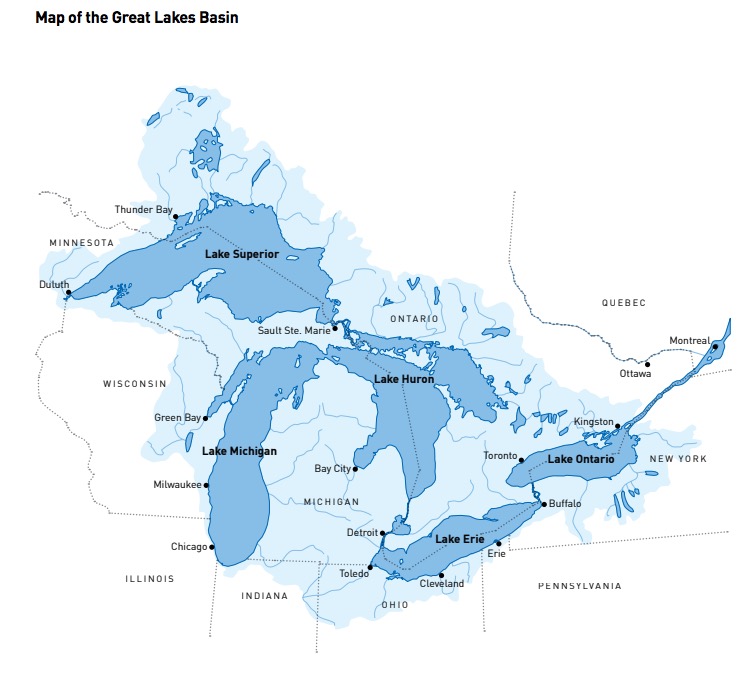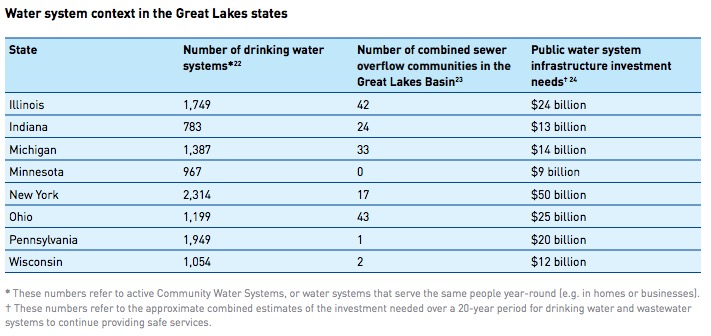US WATER ALLIANCE
Introduction
 The Great Lakes region is defined by water. The lakes are an important national resource, holding 90 percent of the country’s fresh surface water and supplying drinking water to more than 48 million people in the US and Canada.1 Water is the foundation of the region’s identity, and is essential to its environmental, social, and cultural fabric. The region’s leaders have long understood the value of water and have a proven track record of working together to protect and preserve water resources. To secure a sustainable and prosperous future, stakeholders in the Great Lakes region must build upon these shared values and deepen their focus on fostering equity and inclusion in water management.
The Great Lakes region is defined by water. The lakes are an important national resource, holding 90 percent of the country’s fresh surface water and supplying drinking water to more than 48 million people in the US and Canada.1 Water is the foundation of the region’s identity, and is essential to its environmental, social, and cultural fabric. The region’s leaders have long understood the value of water and have a proven track record of working together to protect and preserve water resources. To secure a sustainable and prosperous future, stakeholders in the Great Lakes region must build upon these shared values and deepen their focus on fostering equity and inclusion in water management.
Once the industrial and manufacturing center of America, the region has struggled to adapt to the post-industrial economy, leaving many cities with high poverty rates and declining populations. Long after the rest of the country has begun to bounce back from the Great Recession, many Great Lakes cities still face widespread unemployment and distressed housing markets. While the region is seeing employment growth in the education, healthcare, logistics, advanced manufacturing, and service sectors, this growth has not been enough to alleviate economic inequalities, in part because these growing sectors do not provide the stability and prosperity that manufacturing jobs did in the past.
As the economy changes, the region is also experiencing significant demographic shifts. Diversity is increasing as people of color and immigrants lead population growth. These growing populations are held back from full participation in the economic and social fabric of the region: communities of color and lower-income people in the region tend to be concentrated in areas with lower-quality infrastructure and environmental challenges.
As the Great Lakes region undertakes planning, policy development, and investments to revitalize its economic base, water is a cornerstone for future growth and prosperity. Jobs in economic sectors that depend directly on water infrastructure generate $447 billion in wages annually. Almost a quarter of the jobs in the region are in water-dependent industries such as agriculture, recreation, and manufacturing. Indeed, water is a fundamental strength upon which the region can build.
The Great Lakes region must also focus on equity and inclusion if economic growth is going to be sustainable in the long term. Making sure that disadvantaged communities have the opportunity to participate in the economic and social life of the Great Lakes strengthens the whole region. Studies have found that greater economic and racial inclusion stimulates more robust growth,8 as well as the converse—racial and economic segregation holds back the whole economy in addition to individuals and communities.
While equitable water management will not solve the Great Lakes’ socioeconomic challenges on its own, it is an essential component of future prosperity. Water is closely tied to public health, the economy, and the environment. The historical patterns that have shaped a deeply divided region, such as segregation and disinvestment, have also shaped the disparities in water quality and service. Making water management more equitable can provide the Great Lakes region with economic, health, and social benefits to drive long-term progress.
If any region can chart an equitable water future, it is the Great Lakes. The region has a long history of actively working towards the common good through its community-based organizations, foundations, environmental advocates, research institutions, regional governing bodies, and utilities. Now is the time to harness this culture of collaboration to make progress on inclusive water management in the region. By creating a shared vision that highlights the interconnections between water and equity, we can advance policies and practices that will bend the region’s future to be better for everyone.
This report is organized in the following manner:
- The Pillars of Water Equity offers a vision for creating more equitable water systems;
- Priorities to Forge Progress takes a closer look at nine big challenges facing vulnerable communities in the region and describes strategies to advance water equity, illustrated by case studies; and
- Conclusion: Regional Assets to Secure an Equitable Water Future describes the characteristics, institutions, and resources that the Great Lakes region can draw on in advancing equitable water management.
It is our hope that this report inspires action to build a more equitable future for the Great Lakes region.
Download full version (PDF): An Equitable Water Future
About the US Water Alliance
uswateralliance.org/
“The US Water Alliance is driving a one water movement. We envision a future where all water is valued. Irrigation on a farm. Water from the tap. Stormwater. Water flowing toward a treatment plant. Water, in all its forms, is valuable, and our collective future depends on water. At the US Water Alliance, we are transforming the way the nation values and manages our most precious resource.”
Tags: Great Lakes, Illinois, Indiana, Michigan, Minnesota, New York, Ohio, Pennsylvania, US Water Alliance, Water, Water Equity, Water Infrastructure, Wisconsin







 RSS Feed
RSS Feed